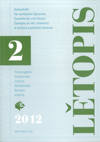„Serbow dobyća“ – Der Disput über die „Echtheit“ eines sorbischen Volkslieds
„Serbow dobyća“. The dispute about the “authenticity” of a Sorbian folksong
Author(s): Susanne HoseSubject(s): Customs / Folklore
Published by: Domowina-Verlag GmbH / Ludowe nakładnistwo Domowina
Keywords: folksong; Sorbian; Mìtšk; Smoler; Serbow dobyæa; Boles³aw Chrobry; Václav Hanka; Volkslied; sorbisch
Summary/Abstract: Two opposing views published in “Lětopis” (Mětšk 1961, Raupp 1967) draw attention to an academic dispute, which has caused vehement arguments amongst Sorbian scholars, about research into the “true” age of the epic tradition amongst the Western Slavs. Investigations at the Institute for Sorbian Ethnic Research also contributed to this debate. Frido Mětšk declared 1956 the Lower Sorbian war song “Naše golcy z wójny jědu” to be the oldest obvious example of Sorbian folk literature in the Middle Ages. His conclusion was confirmed by Jan Rawp’s investigations (1957). Wolfgang Gesemann, who taught Slavonic Studies in Mainz, disputed the “authenticity” of the song “Serbow dobyća”, which is described in the “Pjesnički” (Haupt/Smoler 1841/43), as presumably having its origins in “the battles of the Wends against the Germans, perhaps in the time of Bolesław Chrobry”. Because Gesemann was not able to answer his own queries satisfactorily, he passed them on to the research centres in Bautzen, Leipzig and Prague with a piece of advice about methodology, namely that they should investigate the life of the famous collector of folk songs, Jan Arnošt Smoler, and his links with Václav Hanka, the discoverer of the Königinhofer and Grünberger manuscripts, which were so important for the Czech national renaissance . What is the purpose of our interest in the wealth of epic songs? Cultural researchers into narrative forms are rightly sceptical when dealing with the question of allegedly unbroken oral traditions stretching over centuries and the label “authentic”. The practice of repeated copying, translation and linguistic matching in itself only strengthens these doubts. The author analyses the origins of the myth of an “ancient” epic tradition by addressing the motivation of those who collected and edited the songs, fairy stories and legends etc up to the present day.
- Issue Year: 2012
- Issue No: 2
- Page Range: 18-39
- Page Count: 22
- Language: German
- Content File-PDF

